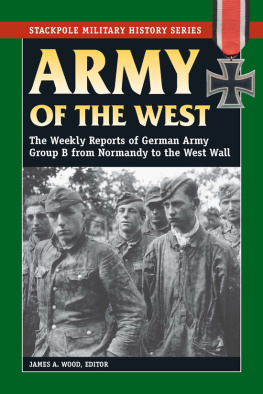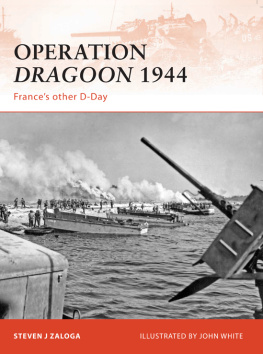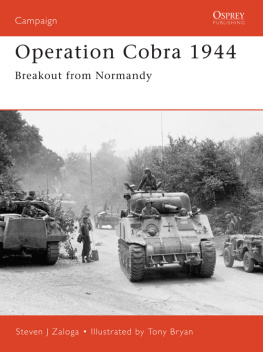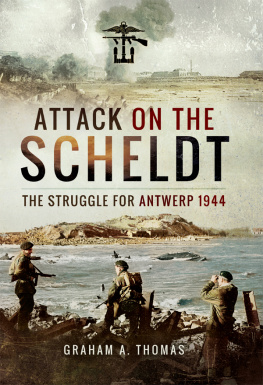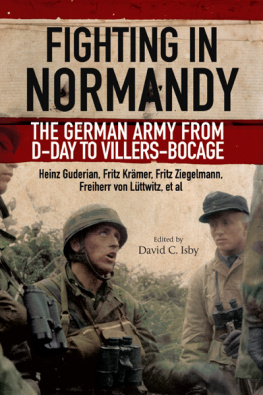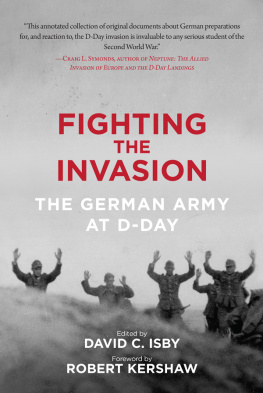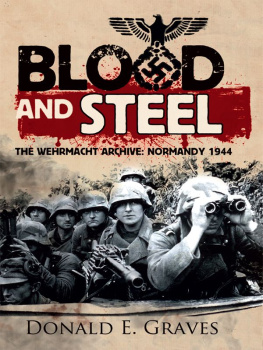APPENDIX 1
German Commander Biographies
SUPREME COMMAND OF THE ARMED FORCES
(OKW: OBERKOMMANDO DER WEHRMACHT)
Keitel, Wilhelm
Field Marshal Wilhelm Keitel was OKW Chief of Staff. Along with Jodl and Warlimont, he relayed Hitlers orders to commanders in the field and conveyed their messages to Hitler, usually in the gentlest way possible. Over the course of the war, OKW became a rubber stamp for Hitler, a travelling headquarters that followed the Fhrer wherever he went. It oversaw operational planning, foreign intelligence, supply, and a wide variety of general concerns and problems. Keitel was noted for his ability to say what Hitler wanted to hear and for keeping unpleasant news from the Fhrer. He had been a staff officer since 1915 and after the Nazis came to power Keitel received promotions by remaining attached to Hitler. His obsequious ways were detested by many who had to deal with him, notably von Rundstedt, and Keitels role as Hitlers man probably accounted for the fact that he held his position until the end of the war. On May 8, 1945, Keitel ratified the final German surrender. He was later executed on October 15, 1946, following his trial at Nuremburg.
Jodl, Alfred
As Keitels deputy, Colonel General Alfred Jodl was OKW Chief of Operations. His primary function was to translate Hitlers strategic orders into writing. Jodl had been at Hitlers side since 1940 and, like Keitel, was noted for the talent of being able to tell the Fhrer bad, often catastrophic, news from the battlefield while at the same time minimizing the fallout from Hitlers temper. As a highly competent staff officer, Hitlers confidant, and top advisor at the Wolfs Lair, he was considered by many to be the most important man at OKW. As with Keitel, he rose through a succession of staff appointments, and to the bitter end Jodl was unshakably loyal to Hitler, to the extent that he was often indifferent to the ideas and demands of field commanders. Keitel and Jodl remained at the head of OKW until the German surrender, a remarkable fact in light of the firings and suicides witnessed in the latter part of the war. Jodl signed the Instrument of Surrender on May 7, 1945. At his execution in Nuremburg, he quietly uttered, I greet you, oh my Germany.
Warlimont, Walter
General of Artillery Walter Warlimont was Jodls Deputy Chief of Operations. On August 2, 1944, he was sent to Army Group B Headquarters to personally deliver Hitlers plans for Operation L TTICH , the counterattack that took place the following week at Mortain. In addition, he was being sent to keep an eye on von Kluge, whom Hitler was beginning to suspect of disloyalty. Opposition to L TTICH by the field commanders, von Kluge, Hausser, Eberbach, and Deitrich, was unanimous. Warlimont insisted that the commanders were to hold with determination; no retreat could be considered. He later signaled Hitler: Everyone here confident of success. At this stage of the war, it would be suicidal to tell the Fhrer what he did not want to hear. Warlimont suffered severe injuries in the July 20 attempt on Hitlers life and thus was not with the OKW entourage in Berlin at the end of the war. After the surrender, Warlimont was taken prisoner by American forces.
COMMANDER-IN-CHIEF WEST
(OB WEST: OBERBEFEHLSHABER WEST)
Rundstedt, Gerd von
Field Marshal Gerd von Rundstedt commanded the German West Army, with sixty divisions under his command as of June 6, 1944. Rommels Army Group B was stationed in Holland, Belgium, and northern France, and included the Fifteenth Army along the Channel coast east of the Seine as well as the Seventh Army between the Seine and the Loire Rivers. Von Blaskowitzs Army Group G was stationed in Southern France, with the First and Nineteenth Armies. Considered trustworthy by Hitler, von Rundstedt was recalled from retirement twice, first in 1939 as commander of Army Group South for the Polish and Russian campaigns, and again in 1942, at age sixty-four, as C-in-C West. He held this position almost until the end of the war, excluding the period from July 7 to September 5, 1944, during which time Field Marshals von Kluge and Model replaced him as C-in-C West. Von Rundstedt was an old-guard Prussian officer and a respected strategist, but he held no illusions regarding his armys ability to repel a massive invasion by an enemy whose main point of assault could not be determined in advance with any degree of certainty. He was enraged on D-Day by Hitlers delay in releasing the OKW reserves. At the height of the battle for Normandy, Hitlers conviction that the aging Field Marshal no longer held faith in ultimate victory led to von Rundstedts replacement by von Kluge. He was later reinstated as C-in-C West on September 5, freeing up Model to assume command of Army Group B for the remainder of the campaign in northwest Europe. Von Rundstedt retired on March 11, 1945, and was replaced by Kesselring.
Kluge, Gnther von
Field Marshal Hans Gnther von Kluge replaced von Rundstedt as C-in-C West on July 7, 1944, and later took command of Army Group B as well after Rommel was critically injured on July 17. Von Kluge had been a favorite of Hitler when he commanded Army Group Center in Russia, where he succeeded in developing lines of defense that held for two years. His messages were often passed directly to Hitler. Clever Hans arrived in France with high spirits, intending to make the counterattack that von Rundstedt was unable to pull together. He soon became disillusioned, however, to the point where he sent a brutally frank message to Hitler on August 3 outlining the dire consequences that would result from the implementation of Operation L TTICH . He showed some support for the July 20 conspirators, but ultimately refused to act against the Fhrer when the time came. After the assassination attempt, von Kluge fell under suspicion of complicity with the plot and was also believed to be trying to negotiate a surrender agreement with the Allies when he went missing on August 15. When Hitler appointed Model to replace von Kluge, the latter committed suicide before he could be recalled to Berlin. He left a final letter for Hitler, protesting his undying loyalty to the Fhrer and urging him to negotiate peace if his counteroffensive did not bring victory. Hitler, unimpressed, denied von Kluge any military honors at his funeral.
Model, Walter
Recognized as Hitlers Fireman and a master of defensive operations, Field Marshal Walter Model commanded Army Groups North and South on the Eastern Front and, in June 1944, brought the Soviet drive against Army Group Center to a halt outside Warsaw. On August 17, 1944, he was transferred to Normandy to replace von Kluge as C-in-C West, at which point he also took command of Army Group B in Rommels absence. Model worked his men hard, but only within the limits of what was possible. He was replaced by von Rundstedt as C-in-C West on September 5, but stayed on as the commander of Army Group B to coordinate the German defense against Allied airborne landings at Arnhem. He later helped to plan the Ardennes offensive. Towards the end of the war, Model was trapped in the Rhr pocket with his 200,000-man force. Having let Hitler down, Model drew his Luger and shot himself in the head.
Blumentritt, Gnther
Major General Gnther Blumentritt was Chief of Staff to von Rundstedt, von Kluge, and Model at OB West headquarters in St-Germain. Before dawn on June 6, 1944, in Rommels absence, Blumentritt called Jodl at Berchtesgaden requesting permission to move the Panzer Lehr Division to the beaches, but was told to wait until daylight reconnaissance clarified the situation. On August 2, Blumentritt met with Warlimont to receive the plans for Operation L TTICH and was angered by the unrealistic objectives of the Mortain offensive. Warlimont repeated the official line: There would be no retreat; the lines would be held with fanatical determination.

